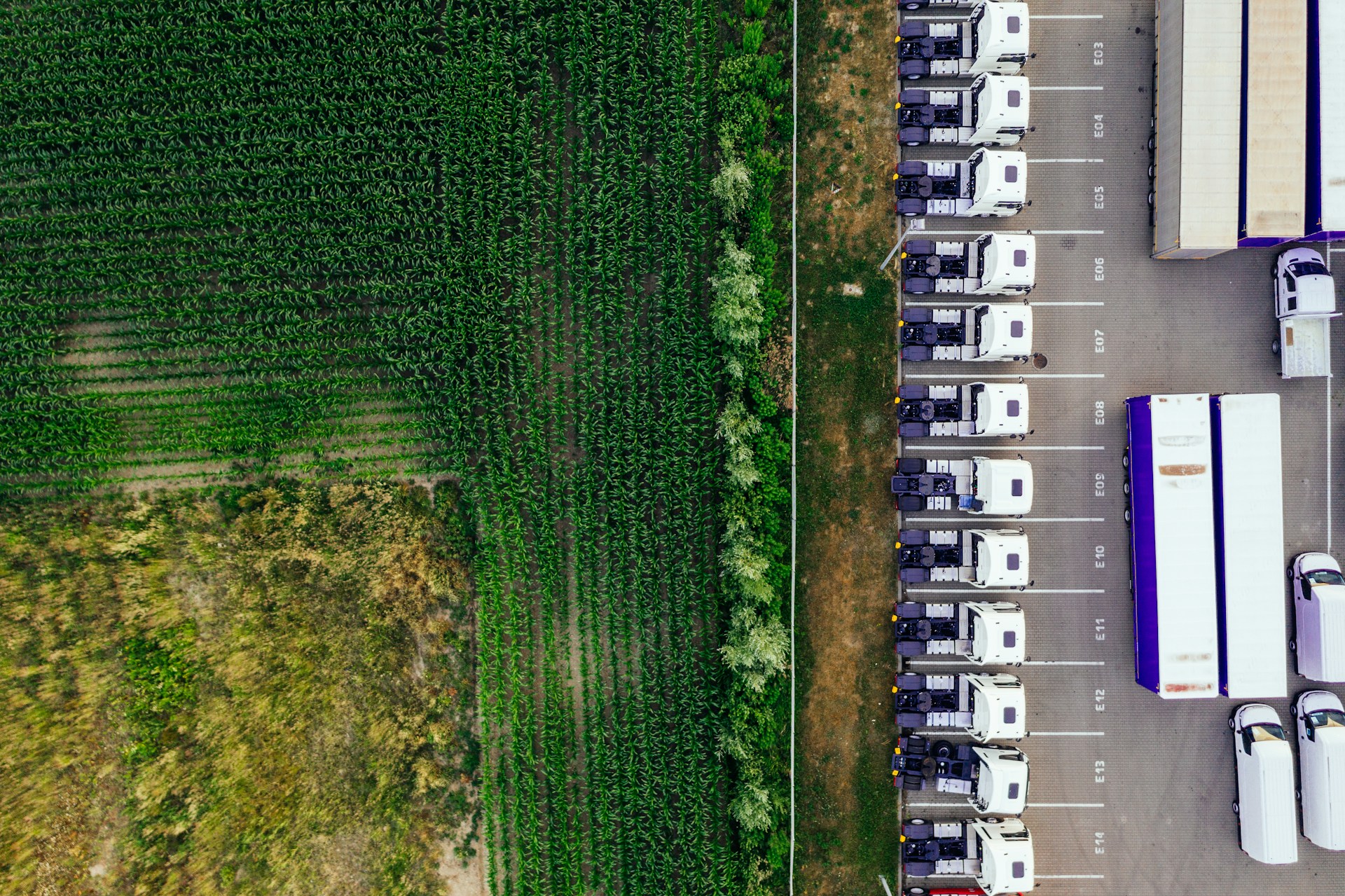In the world of produce shipping, unpredictability is a constant factor.
From unforeseen weather conditions to logistic disruptions, various risk elements can negatively impact this industry.
However, one can foster resilience and ensure business continuity by leveraging the protection offered by insurance.
With it, shippers can secure compensation for losses, maintain profitability, and sustain operations even when disaster strikes.
This form of financial security is crucial for companies keen on preserving their competitive edge in the global market.
Let’s delve deeper into strategies that can help optimize insurance usage and mitigate risks in the realm of produce shipping.
Contents
- Ways To Mitigate Risks With Insurance In Produce Shipping
- 1. Purchase comprehensive cargo insurance.
- 2. Use Refrigerated Containers for Perishable Goods
- 3. Regular Vehicle Maintenance Checks
- 4. Track Cargo to Monitor its Transportation
- 5. Use reliable, insured shipping companies
- 6. Package products properly to avoid damage.
- 7. Train Drivers in Safe Handling of Goods
- 8. Implement risk management plan.
- 9. Insure against Theft and Loss
- 10. Weather Insurance for Outdoor Delays
- The Bottom Line
Ways To Mitigate Risks With Insurance In Produce Shipping
1. Purchase comprehensive cargo insurance.
When reviewing shipping options for perishable goods, a crucial consideration is to purchase comprehensive cargo insurance.
This kind of insurance aids in covering losses incurred due to a myriad of events that can potentially disrupt or damage your cargo during the shipping process.
With comprehensive coverage, interruptions and disruptions from natural disasters, accidents, or cargo theft are mitigated.
Bearing the full cost of such events without insurance could prove detrimental to your business’ financial health.
It is important to note that not all cargo insurance policies are equal.
You must ensure that your policy covers the complete loss of cargo, and not just a fraction of it.
Additionally, the policy should cover all forms of possible cargo damage, including that caused by harsh weather conditions.
It’s essential to read and understand the fine print of the insurance policy before making any commitments.
Further, it’s advisable to seek advice from professionals or legal experts to analyze the insurance contract and help your business understand the terms in depth.
Having this understanding will ensure you are not subjected to unexpected costs or unnecessary liabilities.
Consider the type of goods you are shipping.
The type of goods significantly affects the premiums and the kind of coverage required.
Perishable items, for instance, may need a more specialized form of coverage given their susceptibility to spoilage during transit.
A comprehensive cargo insurance policy will not only protect your goods but also give your business a competitive edge.
This is due to the assurance given to your customers that their goods are covered in case of any unforeseen circumstances.
However, remember to be clear with your insurer about the nature of your goods and their destination to avoid any complications when making claims.
To sum up, when shipping perishable goods, obtaining a comprehensive cargo insurance policy is an invaluable investment that offers a safety net against the various risks attributed to the shipping process.
2. Use Refrigerated Containers for Perishable Goods
Utilizing refrigerated containers for transportation is crucial when dealing with perishable goods such as fruits, vegetables, dairy products, and other fresh produce.
The perishable nature of these commodities runs the risk of rapid spoilage, making them susceptible to temperature fluctuations during transportation.
Perishable goods have specific temperature requirements to maintain their freshness and prevent damage.
Maintaining a controlled temperature environment during transportation is key; hence, the need for refrigerated containers.
Refrigerated containers are designed with temperature control systems that maintain the required coldness despite external weather conditions.
Without this level of temperature control, carriers risk exposing the produce to conditions that could lead to spoilage and loss of quality.
This method of transportation acts as insurance, offering a layer of protection against cargo damage due to spoilage and loss of product quality.
By using these containers, businesses can mitigate the financial losses associated with perishable cargo spoilage.
Importantly, consistent use of refrigerated containers also boosts customer confidence, as it guarantees their product’s freshness and quality upon delivery.
Scrupulous monitoring of temperatures is necessary to ensure the produce remains in an ideal state during its journey.
Using refrigerated containers is a proactive approach to reducing the risk in produce shipping.
Admittedly, the investment in refrigerated transportation may be higher, but this is significantly outweighed by the benefits of improved cargo safety.
More importantly, this is a solid strategy that contributes to the overall risk management plan of a shipping company dealing in perishable goods.
Insurance companies also look favorably on firms using refrigerated containers as it drastically reduces the risk profile of their cargo, potentially leading to lower insurance premiums.
Despite the initial cost, the long-term financial benefits and risk mitigation make refrigerated containers an absolute necessity in the shipping of perishable goods.
3. Regular Vehicle Maintenance Checks
One of the primary ways to mitigate risks in produce shipping is to conduct regular vehicle maintenance checks.
Regular maintenance helps ensure that the vehicles used for shipping are in optimal condition, reducing the risk of breakdowns and delays in transit.
This aspect is essential because delayed shipments due to vehicle malfunctions can result in significant losses, as fresh produce has a limited shelf life and can quickly spoil.
Maintenance checks should involve thorough assessments of both the vehicle’s mechanical components and the refrigerated containers.
Ensuring that the refrigerated containers are functioning at peak efficiency is vital as any variance in temperature can negatively affect the quality of the fresh produce being transported.
This includes confirming that the temperature control systems are properly working to keep the produce at acceptable temperatures throughout the journey.
In addition, the maintenance checks should also involve reviewing fuel systems, brake systems, electrical systems, and other critical vehicle components.
Regular vehicle checks can prevent sudden breakdowns and improve the overall reliability of the vehicle, leading to minimal disruptions in the supply chain.
Another significant benefit of regular vehicle maintenance is the potential to lower insurance premiums.
Insurance companies often offer reduced rates for companies that show a strong commitment to vehicle upkeep and preventative measures as it reflects a reduced risk of accidents and claims.
Fleet management software can be employed to automate the process of vehicle inspections and generate routine maintenance schedules.
This automated approach can cut down on the time and resources needed to manage this crucial task, while also minimizing the risk of oversight in the scheduling of necessary maintenance and inspections.
Furthermore, teaching drivers to monitor for and report any signs of vehicle wear and tear can also support the early detection of issues that could potentially escalate if left unaddressed.
Produce shipping companies that prioritize regular vehicle maintenance checks contribute substantially to the mitigation of risk their operation, boosting their overall efficiency and reducing potential losses.
Therefore, regular vehicle maintenance checks should hold a prime spot in the risk management plan of any fresh produce shipping operation.
4. Track Cargo to Monitor its Transportation
One significant way to mitigate risks involved in produce shipping is by investing in effective cargo tracking mechanisms.
Real-time cargo tracking technologies allow produce shippers to monitor the conditions and location of their goods during the transportation process.
Benefits of this method range from ensuring goods’ safety, timely delivery, to eliminating unnecessary loss due to misrouting.
The implementation of cargo tracking increases visibility and provides extensive data and information about cargo movements.
This knowledge is incredibly useful when dealing with perishable goods that may be time-sensitive and require specific conditions during transport.
Monitoring systems can send alerts if there are delays or changes in the environment that could potentially harm the goods.
Investing in cargo tracking technologies allows shippers to intervene promptly when certain risks are identified, thereby minimizing potential loss and ensuring the produce reaches its intended destination in optimal conditions.
For instance, real-time tracking can provide alerts if the refrigerator unit in a freight truck fails, allowing the shipping company to take immediate action to prevent spoilage.
Aside from providing timely data and information, cargo tracking allows for more responsible management of the supply chain.
Shippers can have a better understanding of their carrier’s reliability by analyzing transit times and delivery success rates.
Cargo tracking can also provide information about system inefficiencies that can be refined for future shipments.
Knowing when and where delays tend to occur can help shippers to plan more effectively and reduce the risk of encountering the same issue.
It is important to consider, though, a comprehensive risk management strategy involves more than just cargo tracking.
Shippers should still consider other forms of protection, such as insurance against theft, loss, or weather-related issues.
However, when coupled with other mitigation strategies, tracking cargo can play a significant role in minimizing risks associated with produce shipping.
5. Use reliable, insured shipping companies
Using reliable and insured shipping companies is an essential approach to mitigate risks with insurance in the shipment of produce.
When it comes to choosing a shipping company, it’s vital to investigate their reliability and insurance policies.
Shipping with a company that has a solid reputation for reliability reduces the chance of delivery delays, which can cause spoilage for produce.
A fine reputation is often built upon consistency in on-time deliveries and the correct handling of goods.
Therefore, by choosing a reliable shipping company, you create a safer passage for your produce, which results in minimized losses and more significant profits.
On the other hand, insured shipping companies provide a safety net in the event of unexpected circumstances.
Every shipping company faces risks of accidents, theft, or severe weather conditions that can disrupt the transportation of goods.
Therefore, it is essential that the shipping company you choose has comprehensive insurance coverage to compensate for loss in these scenarios.
Notably, there are different kinds of insurance that shipping companies may have, and it’s important to choose a company that has a juxtaposition of suitable policies.
For example, Liability Insurance covers any destruction or loss that comes about as a result of the shipping process, while Cargo Insurance compensates for damage to the goods during transportation.
Furthermore, in some cases, the shipping company might also hold a Goods In Transit Insurance, which covers the goods between the process of pickup and delivery.
In addition to the insurance coverage offered by the shipping company, it could be beneficial for the shipper to get their own cargo insurance policy.
Independent cargo insurance can offer additional protection, supplementing the insurance already provided by the shipping company.
Having reliable, insured shipping companies paired with independent cargo insurance means you are leveraging the insurance system to the highest level in order to protect your produce.
To sum it up, while shipping produce, it’s essential to use a shipping company that carries a commitment to reliability and comprehensive insurance coverage, implementing double-layered protection and hence providing crucial ways to mitigate risks in the transportation of produce.
6. Package products properly to avoid damage.
In the realm of produce shipping, effective packaging can play a crucial role in minimizing the potential risk of product damage.
An important concept to understand is that non-optimized packaging can lead to bruising, spoilage, and the decimation of entire crops during transit.
That’s why shipping industries have engineered specific packing methods to secure the protection of fresh produce during transit.
The art of perfect packaging in produce shipping is to create a balance between protection and cost effectiveness.
To ensure the most conducive packaging, there’s often a need for the utilization of cushioning materials, such as bubble wrap, foam packaging peanuts, or inflatable air pillows, all of which can significantly reduce the risk of damage to the produce.
Additionally, products should be boxed in secure, high-quality containers that possess the strength to withstand the rigors of the shipping process.
Nowadays, many businesses are turning to eco-friendly packaging solutions, such as biodegradable packing peanuts and recycled cardboard boxes, not only for their environmental benefits but for their ability to provide robust protection.
Another consideration that can help protect produce is the use of temperature-controlled packaging, which leverages insulating materials and, in some cases, the incorporation of refrigeration technologies to maintain an optimal product temperature.
This is particularly essential for perishable goods like fruits, vegetables, or other heat-sensitive products that can easily spoil if exposed to inappropriate temperatures.
It is also crucial to ensure that products are not overpacked or underpacked as both can cause damage.
Overpacking can lead to pressure buildup, causing squashing of products, whereas underpacking can give room for excessive movement, causing bruising during transit.
In effect, all products should be packed according to a predefined packing layout that provides the optimal balance between product safety and cost.
Additionally, training staff in the art of effective produce packaging is pivotal, as correct implementation of packaging techniques can further drive down the risk of product damage.
Remember, in produce shipping, the principal goal is to securely deliver fresh, undamaged goods to the customer, and packaging contributes in a significant way to achieving this.
Therefore, investing in proper packaging isn’t just a necessity – it’s a strategy that can help mitigate the risk of loss from product damage, and ultimately safeguard the financial integrity of the shipping business.
7. Train Drivers in Safe Handling of Goods
Training in the safe handling of goods is arguably one of the most imperative aspects in mitigating risks during produce shipping.
This includes educating drivers on how the materials they’re transporting are handled correctly, which is crucial in preventing potential damages or losses.
When employees know how to handle various types of produce, they’re less likely to accidentally cause damage.
For instance, certain types of fruits and vegetables can be fragile and may require delicate handling during loading and offloading.
Fruitful preparation and training of the drivers can therefore significantly reduce the chances of losses that could affect the bottom line of your business.
The use of professional training services or in-house training programs could be instrumental in helping drivers to efficiently handle your produce.
Moreover, drivers trained in handling freight are not just more efficient; they also increase their productivity.
Well trained drivers are more likely to have all of the necessary knowledge to handle emergencies, minimizing losses during such scenarios.
The drivers should also be trained in the effective use of the most recent technology, such as temperature monitoring equipment for keeping perishables fresh.
Another crucial yet understated aspect of training is boosting the drivers’ knowledge about the most efficient transport routes.
Going for the shorter or less traffic-heavy routes often means less time in transit for the produce, which helps maintain its quality.
This ultimately translates to less produce spoilage, better customer satisfaction, and hence higher profitability.
Proper training should also involve educating drivers on the importance of vehicle hygiene in produce transportation.
Lastly, well-trained drivers are also most likely to adhere to the industry’s best practices, which includes regular vehicle maintenance and safe driving habits, all which reduce the possibility of avoidable setbacks.
Mitigating risks while shipping produce is not a one-time event, but a continuous process that requires both a significant initial investment and continuous input, with driver training playing a crucial part.
8. Implement risk management plan.
To be able to mitigate risks with insurance in produce shipping, it is imperative to implement a risk management plan.
This is a strategic plan designed to identify, analyze and manage the risks inherent in the transportation of perishable goods.
Having a methodically developed risk management plan can help an organization predict and prepare for potential setbacks that may occur during shipping.
In the context of produce shipping, it refers to a comprehensive strategy to prevent, identify, and manage risks associated with the delivery of fresh produce from producer to consumer.
A key part of this strategy is contingency planning, which deals with developing back-up plans in case the initial transportation plans fail.
Another aspect of a risk management plan is risk financing which involves determining how your business will fund recovery activities in the event of a loss.
Risk management also considers employee safety, addressing risks to human health and safety during the process of shipment.
A safety plan, including safety training for staff and operators, can be put in place to reduce the likelihood of injuries.
Furthermore, a risk management plan addresses the risk of damage to goods during transportation by implementing normalizing measures such as proper packaging and handling instructions.
It is a dynamic form of protection, allowing the organization to respond to changing circumstances, such as fluctuations in market conditions or the introduction of new technologies.
An effective risk management plan also includes regular audits and performance evaluations of the risk management processes.
These evaluations make sure that the implemented measures are effective and suggest any necessary improvements.
Overall, an insurance is a great tool but it’s far more beneficial when it’s part of a wider risk management plan.
An insurer can also guide you in shaping your overall risk management strategy, offering insights into potential risks that you might have overlooked.
Therefore, partnering with a reliable insurance provider can be instrumental not only for the risk transfer but also for the development of your risk management plan.
By systematically identifying, assessing, and controlling risks, a risk management plan can minimize the impact of incidents, keeping the goods flowing while protecting the business from unexpected costs.
9. Insure against Theft and Loss
One of the critical aspects in safeguarding the shipment of perishable products is to adequately insure against theft and loss.
This type of insurance serves as a protective layer which ensures that the produce shipper is compensated in case of any unfortunate incidents causing loss or theft to the goods.
Create a clear contract with your insurance company that specifically refers to theft and loss coverage.
Every plan will come with its particular set of conditions, so it is essential to understand your policy’s terms.
Being covered against theft and loss provides an extra layer of security that is invaluable, especially in the shipping business where such incidents are not uncommon.
If the integrity of the cargo is compromised in any way, the policy can be activated and the loss adequately covered.
For instance, if the goods are stolen from the warehouse, the insurance company will cover the losses.
Whereas, if goods are lost during transit due to reasons like misdirection or an accident, the insurance company compensates as per the mentioned coverage terms.
This theft and loss insurance provide a safety net against unexpected incidents and reassure those involved in the shipping chain.
The coverage terms should be tailor-made to suit the individual shipper’s needs considering the goods’ nature and vulnerability.
Insurance experts recommend that the coverage policy should include both theft and lossand not be limited to only one of these.
Furthermore, both explicit conditions, like theft, and implicit conditions, like product spoilage due to unforeseen power failure, should be considered in the policy terms.
With a comprehensive coverage plan, a shipper can focus on other aspects of the business without constantly worrying about potential losses.
Therefore, properly understanding and implementing theft and loss insurance is a crucial step towards mitigating risks in produce shipping.
So, any producer or distributor of perishable goods must align their business strategy with a strong insurance plan to insure against theft and loss.
10. Weather Insurance for Outdoor Delays
Potentially, one of the most unpredictable factors in the transportation of goods, particularly produce, is the weather condition.
In many cases, bad weather can cause significant delays in shipment schedules, causing severe impacts on the freshness and quality of the produce.
This is where weather insurance can play a crucial role in mitigating risks associated with outdoor delays.
Weather insurance serves as a safety net to protect companies from unpredictable weather events that may cause significant delays in their shipment schedules.
Weather insurance is designed to protect companies from the financial losses they might face due to delays caused by unpredictable weather conditions.
For instance, if a shipment of fresh produce is delayed due to a snowstorm, the insurance can cover the extra costs incurred for the delay, such as re-routing or storage fees.
Furthermore, in the worst-case scenario, if the delay leads to the spoilage of the produce, the insurance can cover the loss of income resulting from the wasted products.
It’s important to note that not all weather insurance policies offer the same exact coverage.
Insurance policies vary widely, so it’s crucial for businesses to carefully review the terms and conditions of their policy before purchasing.
More often than not, weather insurance policies will only cover the direct losses which are caused by specific weather events that are listed in the policy.
This means, if a certain weather event is not listed in your policy, the insurance company may not cover the losses associated with it.
Therefore, it’s essential to understand what types of weather events your policy covers and whether your company is at risk of those.
One more thing to consider when purchasing a weather insurance policy is the deductible.
Deductibles are amounts that policyholders need to pay out of pocket before their insurer starts to pay their claim.
Companies must be financially prepared for the deductible and decide on a comfortable level that they can manage.
By purchasing appropriate weather insurance, businesses can safeguard their shipment of goods from unpredictable weather conditions and ensure their financial stability, despite the possible outdoor delays.
The Bottom Line
Through diligent risk management and the incorporation of various safety measures, the safety and integrity of cargo during transit can be substantially increased.
Comprehensive cargo insurance, coupled with theft and loss insurance, offers financial protection against unforeseen incidents.
The use of refrigerated containers for perishable goods, regular vehicle maintenance checks, and tracking of cargo during its transportation journey exponentially enhances the overall protection.
Engaging reliable, insured shipping companies and packaging products appropriately further bolsters the safety of goods.
Driver’s training in the safe handling of merchandise and having a risk management plan in place all combine to create a robust system that can dramatically reduce cargo losses.
Weather insurance successfully offsets the risk of delays due to unanticipated weather conditions.
Thus, these measures underline the significance of adopting a multi-faceted approach to efficient and safe cargo transportation.




